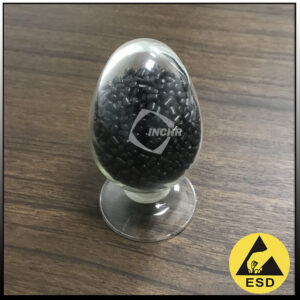In the fields of electronics, electromagnetic shielding, and packaging, the application of conductive (ESD) sheets and conductive (ESD) films is becoming more and more widespread, and the demand is growing. For example, conductive sheets and conductive films can be used to make electromagnetic shielding materials, such as the shielding layer of computer cases, communication equipment shells, etc., which can effectively block the interference and radiation of electromagnetic waves. When producing conductive sheets (such as PP sheets, PS sheets, ABS sheets, etc.) or conductive films (such as PE films, PP films, PA films, etc.), manufacturers will choose conductive masterbatch to improve the conductivity of the materials. That’s because conductive masterbatch has many advantages.

Improve electrical conductivity
As a functional additive, conductive masterbatch can be evenly dispersed in the base material of sheets and films to form a conductive network, thereby significantly improving the conductive properties of the material. For example, adding conductive masterbatches such as graphene or conductive carbon black to plastic sheets or films such as polystyrene can make the originally insulating material have good conductivity and meet the needs of electronic products, sensors, electromagnetic shielding, etc. The demand for conductive materials in the field.
Adjust surface and volume resistivity
By adjusting the dosage of conductive masterbatch, the resistance values of conductive sheets and conductive films can be precisely controlled to adapt to different application scenarios. For example, for electromagnetic shielding materials that require higher conductivity, the amount of conductive masterbatch can be increased; for packaging materials that only need a certain antistatic ability, adding an appropriate amount of conductive masterbatch can meet the requirements.
Simplify production processes
Conductive masterbatch usually has good dispersibility and processability. When producing conductive sheets and conductive films, it can be directly mixed with the matrix material and then processed by extrusion, calendering, blow molding, etc. without additional complicated processing steps, greatly simplifying the production process and improving production efficiency.
Improve production stability
The conductive masterbatch can ensure the uniform distribution of conductive components in sheets and films, reducing the problem of unstable product performance caused by the uneven distribution of conductive substances. For example, during the extrusion production process, the conductive masterbatch can be fully mixed with the matrix material to ensure that the conductive properties of the extruded sheet or film remain consistent throughout the product.
Enhanced mechanical properties
Part of the conductive masterbatch can form a good interface combination with the matrix material, thereby improving the mechanical strength, toughness, wear resistance, and other mechanical properties of the conductive sheet and conductive film. For example, in some conductive film applications that require frequent bending or folding, adding an appropriate conductive masterbatch can ensure that the material will not break or be damaged during repeated deformation.
Improved weather resistance and chemical stability
Conductive masterbatch can improve the weather resistance and chemical stability of sheets and films, allowing them to maintain good conductive properties under different environmental conditions. For example, for conductive films used outdoors, adding a conductive masterbatch with anti-ultraviolet and anti-oxidation properties can extend the service life of the material.




